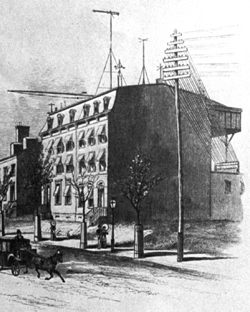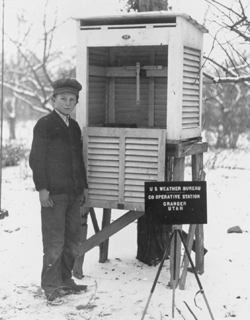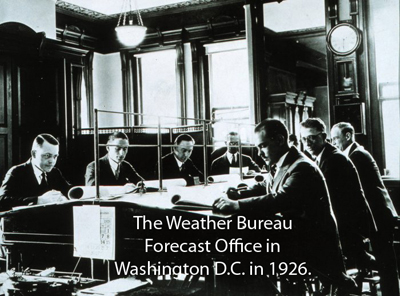 |
 |
|
| The U. S. Meteorological Service headquarter building of the United States Signal Service. In: Frank Leslie's Illustrated Newspaper, N.Y. , Vol. 50, Supplement, May 1, 1880. |
|
WFO Juneau History
Although weather observations were taken by the Department of Agriculture beginning in 1881, the Weather Bureau didn't officially begin taking observations until January 1917.
The routine of the office during this time was different from that of today. The office was also home to the Officer in Charge (OIC) and his family and Mr. Craven. Coal was the heat source and many winter hours were spent shoveling coal. Observations were taken twice a day early in the morning and during the afternoon. They were then telegraphed to Washington, D.C. for inclusion by the central office meteorologists in their analyses. The family of the OIC or of the assistant was often called upon to take a more active part in the work of the station. May entries in the log note when Mrs. Summers, or the Summers' daughter would be recruited as an emergency assistant. Such emergency assistants, by the way, were used until the late 1930's to fill the voids created when travel, illness or vacancies occurred.
It wasn't until February 1931, that the weather office moved into a "real" office building. 1938 brought five observers and the first full-time forecaster to the weather office.
In February 1942, the de facto regional headquarters was moved to Anchorage. When the headquarters moved to Anchorage, the new OIC, Claude Brown oversaw a tremendous overturning of personnel during his tenure, especially during the war years. Almost 100 different people were employed as aides, forecasters or observers during the 13 years Brown ran the station. Some of these worked only a few days.
On July 1, 1943, the new Weather Bureau Airport Station (WBAS) opened at Juneau's International Airport. Due to pressure for increased and improved services, the now designated National Weather Service re-established a Juneau Forecast Office which moved into room 433 of the new Juneau Federal Building in December, 1973. The airport office was now called Weather Service Office (WSO) Juneau.
July 1, 1979 the WSO at airport closed with the Federal Aviation Administration assuming official observation responsibility.
The WSFO (Weather Service Forecast Office) staff and office moved to the Mendenhall Mall during the Federal Building asbestos removal and remodeling project September 1990. In June 1998, the Weather Forecast Office officially moved to its current location at the back of the valley on Mendenhall Loop Road.
National Weather Service History
The weather has always been important in America. Weather records date back to the earliest settlers and became a prominent activity during the 1740-1770s.
The National Weather Service was first organized through the Organic Act passed by Congress on February 2, 1870 and signed into law by President Ulysses S. Grant on February 9, 1870. The act authorized "the Secretary of War to take observations at military stations and to warn of storms on the Great Lakes and the Atlantic and Gulf coasts." Later that year, the first systematized, synchronous weather observations ever taken in the U.S. were made by "observer sergeants" of the Army Signal Service. The success of the agency through the years made this group of dedicated weather forecasters and observers one of the more popular and well-known federal agencies.
The original weather agency operated under the War Department from 1870-1891 with headquarters in Washington, D.C., with field offices concentrated mainly east of the Rockies. Little meteorological science was used to make weather forecasts during those early days. Instead, weather that occurred at one location was assumed to move into the next area downstream.
In 1891 we moved to the Agriculture Department and changed our name to the Weather Bureau. From 1891 to 1940, the Weather Bureau was part of the Department of Agriculture. These first two decades of the 20th century had a remarkable effect on the nation's meteorological services.
In 1902, Weather Bureau forecasts were sent via wireless telegraphy to ships at sea. In turn, the first wireless weather report was received from a ship at sea in 1905. Two years later, the daily exchange of weather observations with Russia and eastern Asia was inaugurated.
In 1910, the Weather Bureau began issuing weekly outlooks to aid agricultural planning. And in 1913, the first fire-weather forecast was issued. During these times, weather forecasters began using more sophisticated methods including surface weather observations; kite experiments to measure temperature, relative humidity and winds in the upper atmosphere; and later, airplane stations.

Realizing that the Weather Bureau played an important role for the aviation community, and therefore commerce, in 1940, President Franklin D. Roosevelt transferred the Weather Bureau to the Department of Commerce where it remains today. During the late 1940s, the military gave the Weather Bureau a new and valuable tool - 25 surplus radars - thus launching the network of weather surveillance radars. This network still exists, but has expanded to 121 Doppler Radars that allow meteorologists to see the inner workings of storm clouds.
The advent of computer technology in the 1950s paved the way for the formulation of complex mathematical weather models, resulting in a significant increase in forecast accuracy. In 2010, the NWS installed new supercomputers at the National Center for Environmental Prediction capable of making 69.7 trillion calculations per second.
In 1970, the name of the Weather Bureau was changed to the National Weather Service, and the agency became a component of the Commerce Department's newly created National Oceanic and Atmospheric Administration (NOAA).
Today, advances in satellites, radars, sophisticated information processing and communication systems, automated weather observing systems and superspeed computers are the centerpieces of NOAA's National Weather Service that have resulted in more timely and precise weather forecast and warnings for the nation. Dr. John L. "Jack" Hayes, Assistant Administrator for Weather Services adds, "NOAA's National Weather Service is dedicated to using all the tools available and all the skills of our employees to provide decision makers the information they need, when they need it."
These services are supported by organizations throughout NOAA, including NOAA's Satellite and Information Service, which maintains the satellites and data used in weather forecasting as well as historical climate records, and research and products provided by NOAA's Office of Oceanic and Atmospheric Research and the National Ocean Service to improve forecasting ability.
 |
Welcome to WFO Juneau | NWS History | Operations | Forecast Products | Local Area Information |  |
| Marine Forecast | Fire Weather | Hydrology | Satellites |